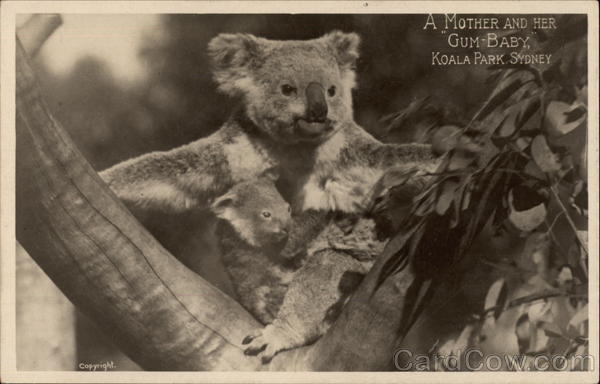Front:
Copyright.
A MOTHER AND HER
GUM-BABY,
KOALA PARK. SYDNEY
Back:
THE NATIVE BEAR OF AUSTRALIA CALLED THE KOALA.
Of the Fauna of Australia the Native Bear stands
quite unique. Briefly, it may be described as arboreal,
phillophageous, gregarious, migratory, sedentary, and
polygamous; of no relation to the true Bear or Sloth
family, being a Marsupial, and an antiquated form of
Australian Fauna. Like other members of the order, the
young of the Koala is born at a tiny immature state and
placed in the pouch by the mother and attached to the
teat where it harbours for 6 months. When fully furred
and about 6 inches long it emerges, continuing to make
use of the pouch for a few more months until too big to
secure accommodation within. Mother Koala will carry
her baby until a year old. On the move she carries it
pick-a-back; when sitting it reclines upon her lap or is
seen clasped in her arms. As a rule, Koalas breed one
at a time every second year. At 4 years young "Blue
Gum"-as often called-is fully grown and may live to
15 years or more. The Native Bear loves the tall trees
of the forest; he is sturdily built and fittingly adapted
with powerful limbs and sharp stout claws to enable
movements aloft with grace and precision. Mostly, how-
ever, he is a sedentary creature often observed sleeping
by day wedged into a fork of a "gum." Seldom will
Bears venture upon the ground, preferring to change
trees overhead if possible. They subsist upon the foliage
of certain Eucalyptus trees. Bears seldom drink, whilst
domestic foodstuffs to them are deleterious, neither will
they survive captivity. From the bush this fascinating
and lovable creature seems gone forever. However, at
Koala Park, near Sydney, N.S.W., a determined effort
is being made to assure future survival of the species
privately by Mr. Noel Burnet and Mr. T. H. Kelly,
being the first and only successful attempt to propagate
Native Bears in captive but natural conditions.
ADDRESS ONLY



